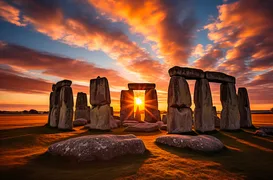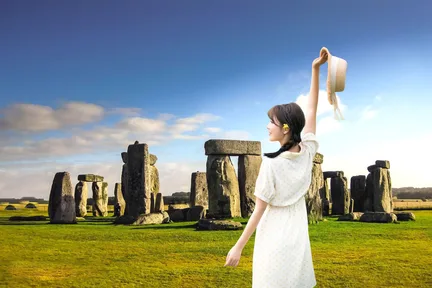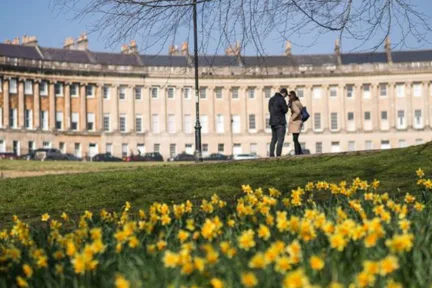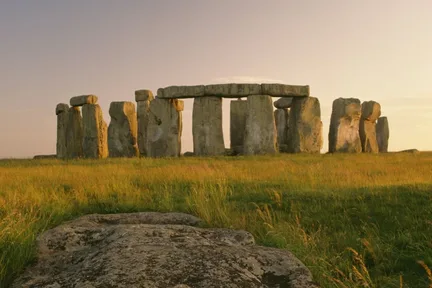Stonehenge

The best of Stonehenge
Bucket-list experiences
Make it a getaway
More to explore
Why people love Stonehenge
Nearby places to go
FAQs about Stonehenge
What is Stonehenge and why is it a mystery?
What is the best time to visit Stonehenge?
What transportation options are available to reach Stonehenge?
What essential travel tips should I know before visiting Stonehenge?
What are the opening hours for Stonehenge?
How much time should I spend at Stonehenge?
Is the Stonehenge wheelchair or stroller accessible?
What to know before visiting Stonehenge
What is Stonehenge?
Stonehenge is one of the world's most famous stone circles, comprising an outer circle of sarsen stones and an inner ring of bluestones. The standing stones, including the Heel Stone and Great Trilithon, are positioned to align with the midsummer sunrise and midwinter sunset. This famous stone circle Stonehenge, located near Amesbury, Wiltshire SP4, is a marvel of ancient engineering, built by the Stonehenge builders during the Stone Age. The UNESCO World Heritage Site is surrounded by other monuments like Stonehenge Avenue and the Altar Stone. The upright stones and mighty sarsen stone circle are also remarkable, offering insight into the ceremonial and religious practices of the time. Stonehenge continues to be a site of archaeological research, offering a glimpse into the past, from its creation to its continuous use over the centuries.
Key Features of the Stonehenge Monument
The Great Trilithon and Sarsen Circle
The Great Trilithon is the tallest structure at Stonehenge, consisting of two upright stones capped by a horizontal lintel. It once stood at over 7 meters high and served as a central focal point of the monument. Surrounding it is the sarsen circle, a series of mighty sarsen stones arranged in a near-perfect circle. These stones were transported from the Marlborough Downs, over 20 miles away, showcasing the incredible effort and coordination of Neolithic builders. The precise layout and engineering of the sarsen circle suggest astronomical and ceremonial significance, particularly its alignment with the sun during solstices.
The Heel Stone and Aubrey Holes
The Heel Stone is a solitary upright stone located just outside the main circle, aligned with the sunrise during the summer solstice. It may have served as a marker or gateway to the sacred space within. The Aubrey Holes, a ring of 56 chalk pits found just inside the outer ditch, are believed to have held timber posts or stones in earlier phases of the site's development. Archaeologists think these holes may have functioned as part of a calendrical system or even as burial sites. Together, the Heel Stone and Aubrey Holes highlight the site's evolution and layered use over millennia.
Visiting Stonehenge
Best Time to Visit Stonehenge
The best time to visit Stonehenge is during the shoulder seasons in spring (April to early June) and autumn (September to October) when crowds are lighter and weather is mild. For a truly magical experience, consider visiting during the summer or winter solstice, when the rising or setting sun aligns with the monument. Early morning and late afternoon slots also offer better lighting for photography and a quieter atmosphere. In recent years, photography these artists explore has captured the spiritual and visual allure of the site.
Stonehenge Accessibility and Visitor Tips
Stonehenge is accessible to most visitors, with paved paths suitable for wheelchairs and strollers. The Visitor Shuttle helps reduce walking distance from the visitor centre to the monument itself. To make the most of your visit:
Book tickets in advance via English Heritage
Dress for the weather, as the site is fully outdoors
Use the official audio guide app or join a guided tour
Allocate 2--3 hours for a full experience, including the visitor centre and surrounding trails
Stonehenge Visitor Centre
The Stonehenge Visitor Centre offers immersive exhibitions on the history and archaeology of the stone circle. Learn about its significance as a burial ground where human remains and cremation cemeteries have been uncovered, and explore the site's construction over many stages. The centre provides a deeper understanding of Stonehenge's cultural importance as a religious site and its alignment with celestial events, such as the summer and winter solstices.
Recently, three exciting emerging artists, including artists Sally Barton Serena, have showcased installations at the centre. Sally Barton Serena Burgis, part of the Echoes Stone Circles community, explores themes of heritage and identity through multimedia work and photography these artists explore further enriches the experience. These exhibitions highlight the influence of the famous stone circle Stonehenge on emerging artists like Sally Barton.
Stonehenge: Surrounding Monuments and Attractions
Beyond the stone circle, the Stonehenge landscape includes several important Neolithic and Bronze Age sites.
Durrington Walls: A large Neolithic settlement thought to house the builders of Stonehenge
Woodhenge: A timber circle believed to have ceremonial links to Stonehenge
The Cursus: A long earthwork running parallel to the Avenue, purpose still debated
The Avenue: A processional route linking Stonehenge to the River Avon
Barrows and Burial Mounds: Scattered across the landscape, these offer insight into the ancient funerary practices
This broader sacred landscape continues to inspire historians and artists alike, especially those involved in the Echoes Stone Circles community, drawing modern meaning from ancient mysteries.



